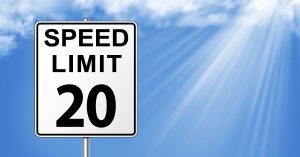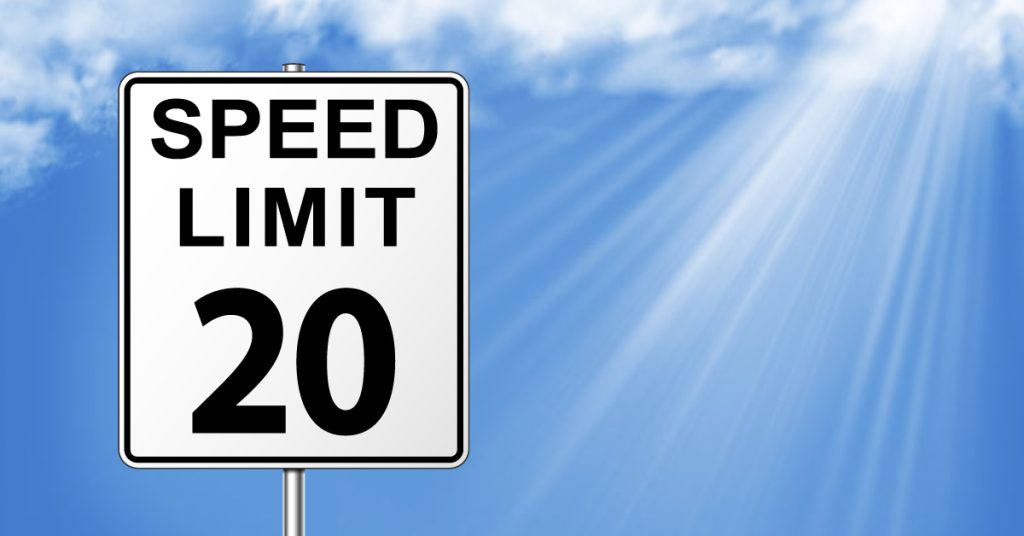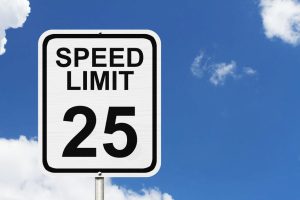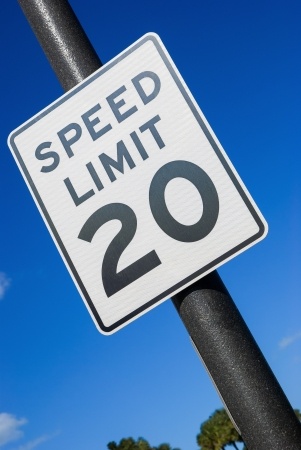Posts Tagged ‘“speed limits”’
In the Battle for Safety, Cambridge Lowers Speed Limits to 20 MPH

Drivers, double check your speed next time you visit Cambridge. In mid-November, the city plans a slow down to 20 mph on most city-owned streets. The city says, when in doubt, go 20 mph.
The City of Cambridge announced the new 20 mph speed limit this week, a decision made in response to residents’ concerns about speeding vehicles and the risk for pedestrian accidents and injuries to cyclists. Cambridge follows Boston and Somerville in pursuing 20 mph speeds on certain city streets. Each city has a VisionZero safety campaign and is working to eliminate traffic fatalities.
Cambridge first lowered speed limits from 30 to 25 mph on most city-owned streets in December 2016. The Massachusetts Legislature granted cities and towns this authority earlier that year with passage of the Municipal Modernization Law. Specifically, communities were given the authority to lower speeds from 30 to 25 mph in locally-owned thickly settled areas.
In response, dozens of communities adopted 25 mph speed limits to reduce the risk of accidents. Few have pursued 20 mph – yet.
But according to the City of Cambridge’s announcement, the law allows communities to establish 20 mph “safety zones” in the interest of public safety. Cambridge will be installing 660 new “safety zone” signs.
The City of Somerville has also taken advantage of this provision of the law. Last we knew, the City of Boston – which was the first to pursue 25 mph, then 20 mph speeds – was still working on the issue. Here is our last update on Massachusetts speed limits (though please note: there may have been additional action since then).
Check a street: Not every street in Cambridge will be impacted. Larger streets like Brattle Street and Cambridge Street will stick with current speeds. Roads under state management – such as Memorial Drive – will not change. You can check out the map here: www.cambridgema.gov/20mph.
It’s worth noting Cambridge’s squares – including Harvard Square, Lechmere Square and Porter Square – won’t see any change. The city lowered speeds to 20 mph back in early 2018.
Cambridge’s Influence on Traffic Safety
Cambridge has been ambitious in making traffic safety improvements. In addition to lowering speeds, the city announced a new City Safety Ordinance earlier this year. The city made the commitment to add permanent separated bike lanes whenever it reconstructs roads identified in the Cambridge Bicycle Plan. With full build out, this would give the city an impressive 20 miles of protected bike lanes. Cambridge Bicycle Safety, a local group, said this could reduce 40 percent of Cambridge bicycle accidents, the one which occur outside intersections.
The city, while committed, does concede there may be cases when these bike lanes aren’t possible due to road conditions.
The bottom line is Cambridge has such a strong influence on transportation in the Boston region, just by virtue of its geography. It borders Somerville, Boston, Arlington, Belmont and Watertown. And because it’s one of the largest cities in Massachusetts, its work to promote safety will be watched across the state and nationally.
Free Legal Consultation – Boston Pedestrian Car Accident Lawyers
Breakstone, White & Gluck has represented accident victims in Boston, Cambridge and across Massachusetts since 1992. Our attorneys are dedicated to our clients and our results. We provide the prompt and thorough investigation required after pedestrian car accidents and bicycle crashes.
If you have been injured by a driver, we offer a free legal consultation to advise you on whether you may pursue a financial claim for your injuries and other losses. Consult one of our personal injury attorneys today at 800-379-1244 or 617-723-7676. You can also use our contact form.
City of Boston Pursues 20 MPH Speed Limit to Reduce Traffic Fatalities and Pedestrian Injuries

In Boston, city officials are interested in lowering speed limits to 20 mph in neighborhoods to reduce traffic fatalities. The proposal comes just two years after the city lowered speeds from 30 to 25 mph and will require state approval.
First, the City of Boston dropped speed limits to 25 mph, with a goal of reducing traffic fatalities and pedestrian injuries. Now, Mayor Marty Walsh and the Boston City Council have their eyes on 20 mph on neighborhood streets. The next step is obtaining state approval.
The City of Boston first sought to lower speed limits as part of its VisionZero campaign a few years ago. That proposal also required approval from the state Legislature and Gov. Baker’s signature.
Gov. Baker signed the Municipal Modernization Bill into law in 2016, including language that allowed cities and towns to lower the default speed limit from 30 to 25 mph. Cities and towns can now lower speed limits on all (or select) municipal roads in thickly settled areas or business districts. Many communities have done so, including Boston, Cambridge, Quincy, Arlington and Dedham. Now, unless traffic signs are posted otherwise, it’s 25 mph in these communities.
While the speed limit in these communities has dropped, the fines remain the same. In Massachusetts, speeding carries a $105 fine for speeding. If you exceed the speed limit by 10 mph, there is an extra $10 fine per each mile per hour.
Boston was the first to approve lower speeds, with this taking effect in January 2017. But the City of Boston’s goal was always 20 mph and remains so for city neighborhoods. In fact, the Boston City Council approved a 20 mph speed limit back in 2016.
As the City of Boston pursues a 20 mph speed limit for neighborhoods, there is early data showing that the 30 to 25 mph drop has changed traffic patterns for the better. According to an Insurance Institute for Highway Safety study, after the lower speed limit took effect, Boston saw a 29 percent reduction in traffic traveling over 35 mph.
Mayor Walsh also announced other transportation initiatives last week, including the creation of special drop-off and pick-up sites for Uber, Lyft and other ridesharing vehicles. Data from the Massachusetts Department of Public Utilities confirms that Boston is the truly the hub of ride-hail services. During 2017, nearly 35 million rideshare trips began in the city. Boston saw more than 6 times as many rideshare starts as Cambridge, which has the second largest presences in Massachusetts.
Walsh’s other proposal is to give every student in the Boston public school system a MBTA pass. The price tag hasn’t been negotiated yet with the MBTA. Currently, the city receives a subsidy from the MBTA and pays $5.6 million for MBTA passes for students in Grade 7 and 8 who live more than a mile and a half from their schools.
Data That Supports 20 MPH
- According to the VisionZero Network, 9 out of 10 pedestrians who are hit by a vehicle traveling 20 mph survive. Increase the speed to 30 mph and the survival rate drops to 50 percent. At 40 mph, just 10 percent of pedestrians survive.
- Speed is a factor in nearly one-third of all traffic deaths in the U.S. (Source: VisionZero Network).
- Speeding crashes claimed the lives of 59,374 people on U.S. roads from 2010 to 2015 (Source: VisionZero Network).
- Cars speeding through red lights are a leading cause of urban car crashes, according to the Insurance Institute for Highway Safety. Some states and local communities permit use of red light and speeding cameras to improve enforcement. But many do not, including Massachusetts and our neighboring New England states. Rhode Island is the one exception, allowing red light cameras by state law and city ordinance. State law permits use of speeding cameras in school zones on weekdays.
Related:
Walsh to propose 20 mph limit in neighborhoods and new Uber, Lyft pickup sites, Boston Globe, March 7, 2019
Slow Down! Boston, Cambridge and Other Cities Have Dropped Speeds to 25 MPH, Massachusetts Injury Lawyer Blog, May 23, 2017
Slow Down! Boston, Cambridge and Other Cities Have Dropped Speeds to 25 MPH
 Over the past year, Boston, Cambridge and several other communities have lowered default speed limits from 30 to 25 mph, with a goal of creating safer streets for pedestrians and cyclists. Now it is Quincy’s turn.
Over the past year, Boston, Cambridge and several other communities have lowered default speed limits from 30 to 25 mph, with a goal of creating safer streets for pedestrians and cyclists. Now it is Quincy’s turn.
Last week, the Quincy City Council passed a measure establishing a speed limit of 25 mph, unless another speed limit is posted. The previous speed limit had been 30 mph. Once Mayor Thomas P. Koch signs the new law, officials will decide on an effective date.
In January 2017, the City of Boston dropped its default speed limit from 30 to 25 mph.
Lowering the speed limit was a key part of the Vision Zero Boston campaign, which was launched by Mayor Marty Walsh in 2015. The goal is to end traffic deaths and serious injuries in the City of Boston by 2030, through a combination of efforts, such as reducing speeds, eliminating distracted driving, and improving infrastructure for safer riding, walking and cycling.
While lowering speed limits was a critical step, the City of Boston was unable to act right away.
First, the city had to obtain approval from the state Legislature and Gov. Charlie Baker. Baker signed the Municipal Modernized bill in August 2016, which gave Boston, as well as cities and towns across the state, authority to reduce the default speed limit on local roads.
So far, these communities have reduced speed limits:
- Boston
- Cambridge
- Somerville
- Arlington
- Newton
- Randolph
- Scituate
- Quincy (approved by City Council)
Source: The Boston Globe.
Benefits to Slower Speed Limits
There is strong evidence that slower traffic means safer streets. An excellent example is New York City. In 2014, the city lowered speed limits to 25 mph on 90 percent of its streets. Over three years, traffic fatalities have decreased 23 percent and fell to the lowest number in the city’s history in 2016.
Boston city officials say that when crashes happen, faster vehicles are likely to cause the most serious injuries and fatalities. According to the City of Boston website, at 20 mph, there is a 17 percent likelihood that someone will be seriously injured or killed. At 40 mph, there is a 79 percent likelihood. Slower vehicles can be stopped more quickly, and the slower speeds allow for longer reaction times.
Read More
City of Boston to Lower Speed Limits to Reduce Traffic Fatalities
 Good news for pedestrians and cyclists: the City of Boston plans to lower speed limits to 20 MPH in some neighborhoods. Officials will also advocate to lower Boston’s default speed limit to 25 MPH.
Good news for pedestrians and cyclists: the City of Boston plans to lower speed limits to 20 MPH in some neighborhoods. Officials will also advocate to lower Boston’s default speed limit to 25 MPH.
Mayor Marty Walsh released the city’s Vision Zero Action Plan last week, including the Neighborhood Slow Streets Program, which will be launched in 2016. A pilot program will introduce traffic calming measures and a 20 MPH speed limit to the Talbot-Norfolk Triangle in Dorchester and the Stonybrook neighborhood in Jamaica Plain. The full program will be launched later in the year and residents across the city can apply.
The default speed limit on local roads in Massachusetts is 30 MPH. The Massachusetts State Legislature must approve any change and it has not acted on past bills. The Metropolitan Area Planning Council, a proponent of the change, has said lowering the speed limit would prevent 2,200 car crashes, 18 fatalities and 1,200 injuries across the state each year. Some $210 million would be saved in medical payments and lost work.
In 2014, Boston Emergency Medical Services treated two to three people each day due to pedestrian and bicycle accidents.
Earlier this year, Mayor Walsh announced Boston would adopt Vision Zero to eliminate traffic fatalities and injuries by 2030. The far-reaching plan includes many infrastructure and technology changes, from the implementation of smart parking meters to building protected bike lanes in crash-ridden areas and better data collection among city departments.
Boston joins other cities around the world in adopting Vision Zero initiatives. The first was adopted in Switzerland nearly 20 years ago. In recent years, New York City, San Francisco and Chicago have adopted plans.
New York lowered its default speed limit from 30 MPH to 25 MPH last year and San Francisco city supervisors began discussing a 20 MPH speed limit last winter.
Read More

